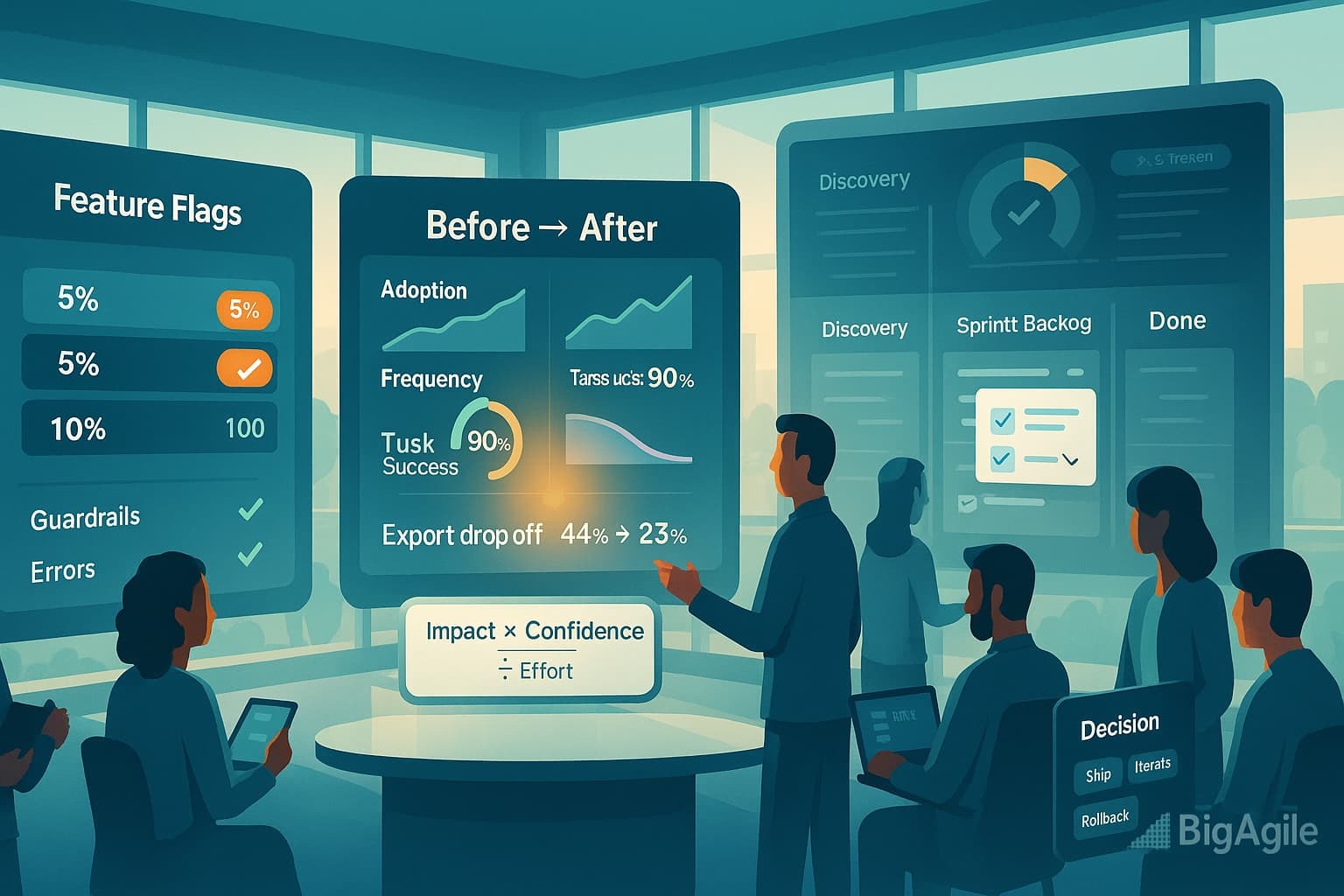
You instrumented five usage signals on Monday, translated them into hypotheses on Tuesday, sliced a thin story with telemetry on Wednesday, and ranked the work with evidence on Thursday. Today you finish the job. Shipping is not the goal, learning is. We will run a safe rollout, watch the right dials, decide with a simple rule set, and feed what we learned straight back into the backlog before Sprint Review.
Set up a safe experiment release.
Goal for the week’s slice
Reduce Export funnel drop-off from 44% to 25% or better, measured on the same dashboard you set up Monday.
Controls and guardrails
Release behind a feature flag
download_export_button.Target one cohort first, for example analysts in plan_tier = Pro on desktop.
Define stop conditions up front: error rate above 2%, p95 page load above +20% of baseline, crash rate above 0.3%.
Ramp plan
| Step | Exposure | Duration | Gate to Advance | Owner |
|---|---|---|---|---|
| Canary | 5% | 24 h | No guardrail breach, export drop-off ≤ 35% | Eng |
| Cohort | 25% | 24–48 h | Export drop-off ≤ 30%, no perf regressions | PM + Eng |
| Scale | 50% → 100% | 48 h | Export drop-off ≤ 25% for 48 h; support tickets flat | PM |
Watchlist, same dashboard, no new tabs.
Track the exact five metrics from Monday so week over week is apples to apples.
Adoption depth for the new button, confirms visibility.
Frequency of export per adopter, catches novelty vs habit.
Task success for filter-apply and export, the core outcome.
Time-in-feature p95, protects expert workflows from slowdowns.
Stickiness 7-day for the export flow, verifies durable lift.
Add two operational dials: crash rate, p95 page load. If either trips a guardrail, pause the ramp and fix first.
Decide with a simple rule set.
| Scenario | What the metrics say | Action | Owner |
|---|---|---|---|
| Win | Export drop-off ≤ 25% for 48 h, guardrails green | Ramp to 100%, retire flag, capture learning | PM + Eng |
| Partial | Improvement, but target not met, no regressions | Iterate one more thin slice next Sprint, keep flag at 50% | PM + UX |
| Miss | No uplift or guardrail tripped | Rollback, run 5 user sessions, pivot hypothesis | PM + Eng + Support |
Keep the vocabulary consistent in stand-ups: win, partial, miss. It reduces debate, speeds the next move.
Close the loop before Sprint Review.
Update the backlog
If win, add a follow-on story only if the metric suggests a next constraint, for example time-in-feature p95 still high for power users.
If partial, log one new slice that targets the next smallest constraint, for example inline validation on the filter panel.
If miss, archive the slice under a “learned” label, link to your notes, and kill the idea. Respect the data, save the team’s time.
Share the learning
One slide, five charts, one sentence per chart.
People care about deltas, not prose: “Export drop-off from 44% to 23%; adoption 62% of DAU; zero perf regressions.”
Thank the people who did the small work that made the big difference, keep morale high.
Retrospective prompts
Where did the Metric → Insight → Story loop feel heavy, where did it feel smooth.
Which acceptance criterion most helped us move fast.
What telemetry should we add earlier next time.
What this looks like in practice next week.
Monday, the dashboard resets to a 28-day view, your new baseline now includes the shipped improvement.
Tuesday, you select the next signal that matters, not the loudest opinion.
Wednesday, you slice again, even thinner.
Thursday, you score with evidence so stakeholders stay aligned.
Friday, you repeat this release playbook, inspect, adapt, and close the loop again.
This cadence keeps discovery and delivery in one conversation. Tools handle the counting, your team handles the meaning, your customers feel the difference.